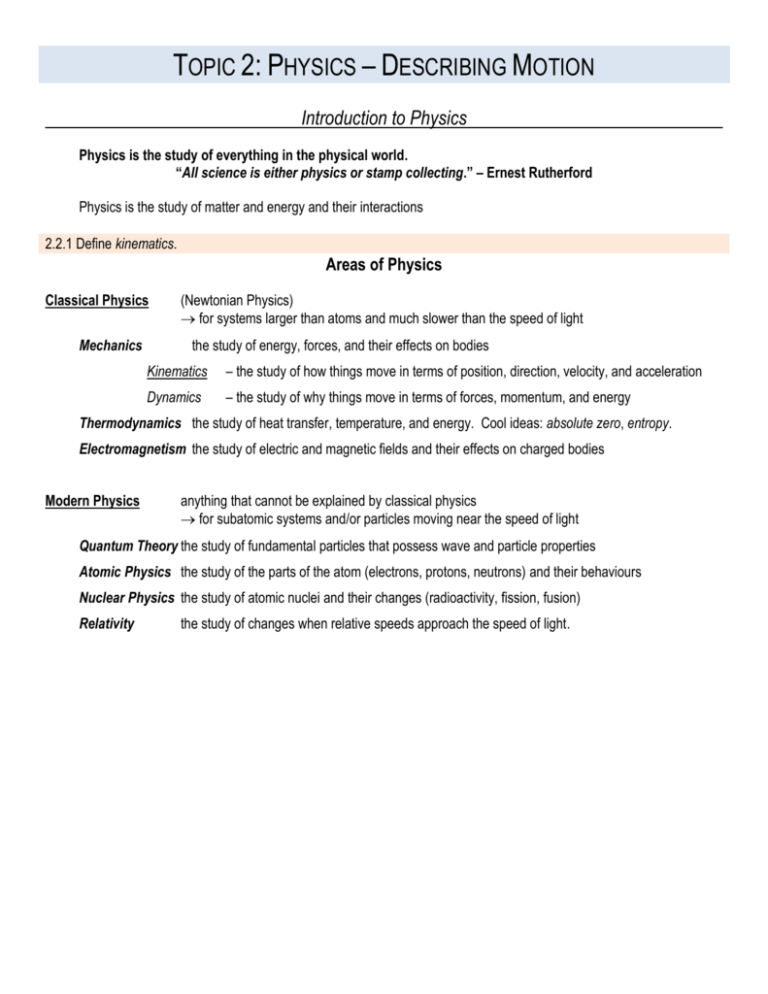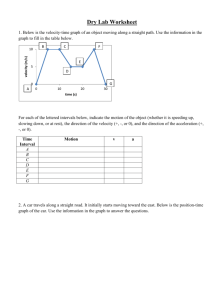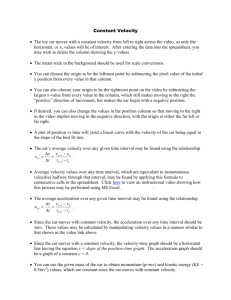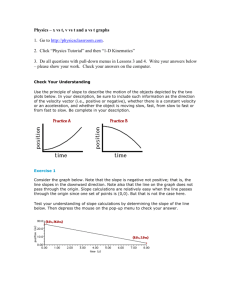docx
advertisement

TOPIC 2: PHYSICS – DESCRIBING MOTION Introduction to Physics Physics is the study of everything in the physical world. “All science is either physics or stamp collecting.” – Ernest Rutherford Physics is the study of matter and energy and their interactions 2.2.1 Define kinematics. Areas of Physics Classical Physics Mechanics (Newtonian Physics) for systems larger than atoms and much slower than the speed of light the study of energy, forces, and their effects on bodies Kinematics – the study of how things move in terms of position, direction, velocity, and acceleration Dynamics – the study of why things move in terms of forces, momentum, and energy Thermodynamics the study of heat transfer, temperature, and energy. Cool ideas: absolute zero, entropy. Electromagnetism the study of electric and magnetic fields and their effects on charged bodies Modern Physics anything that cannot be explained by classical physics for subatomic systems and/or particles moving near the speed of light Quantum Theory the study of fundamental particles that possess wave and particle properties Atomic Physics the study of the parts of the atom (electrons, protons, neutrons) and their behaviours Nuclear Physics the study of atomic nuclei and their changes (radioactivity, fission, fusion) Relativity the study of changes when relative speeds approach the speed of light. 2.1 Vectors and scalars 2.1.1 Distinguish between vector and scalar quantities, and give examples of each. Every measurement in physics has a value (magnitude) and units. Measurements without a direction of motion or force are scalars. Vectors are measurements that have a direction of the motion or force indicated. Scalars quantities that are fully described by a magnitude (or numerical value) alone. Vectors Common Scalar Quantities NO DIRECTION time, t temperature, T mass, m length, ℓ t = 1.23 s T = 293K = 25°C m= 75.6 kg ℓ = 1.14 m quantities that are fully described by both a magnitude and a direction indicate direction in square brackets [ ] after the magnitude Common Vector Quantities DIRECTION in [ ] position, d velocity, v displacement, Δd acceleration, a d = 12.5 m [65° clockwise] v = 25 m s-1 [west] Δd = 23 m [E23°N] a = 9.81 m s-2 [toward ground] In many IB documents, vector variables are indicated by symbols in bold. When identifying variables in text or graph labels, name the variable, its symbol, and its accepted unit(s). Separate name and symbol using a comma. Separate symbol for units using a backslash (/) and use negative exponents when appropriate ex. velocity, v / m s-1 Frame of Reference and Directions 2.1.2 State the direction of a vector using angular conventions: RCS, compass directions Frame of Reference the fixed reference point and set of directional axis relative All observations, descriptions, and measurements are relative to this frame of reference Reference Point the one fixed point from which all positions are measured Coordinate System the set of directions from which all directions are measured Common Conventions for Directions forward up right East North counterclockwise (ccw) + backward down left West South clockwise (cw) – For each situation, you can decide which direction you want to be positive. Interpret the sign of the answer and state the direction according to your convention. Angular Conventions North = 90º RCS West = 180º RCS East = 0º RCS (360º RCS) South = 270º RCS or – 90º RCS RCS Direction = Rectangular Coordinate System All angles measured from positive x-axis (East). 155º 300º = – 60º Compass Direction Angles measured from one cardinal direction (NESW) toward another cardinal direction W 25º N = N 65º W E 60º S = S 30º E 2.2 Kinematics 2.2.2 Define displacement, velocity, speed and acceleration. Position location relative to the origin (reference point) straight-line distance and direction from reference point Use subscripts to label different variables. For three positions, use: d1 d2 d3 or dA dB dC Displacement the change of position the straight-line distance and direction between two positions Δd = dfinal – dinitial Δd = d2 – d1 Standard unit of displacement: metres, m Velocity the rate of change of position the displacement per unit of time v= Δd d 2 -d 1 = Δt t 2 -t1 Standard unit of velocity: metres per second, m s-1 (m/s) Velocity is the slope of a position-time graph. Δy y2 -y1 = Δx x2 -x1 slope for y-x graph m= For position-time graph (d-t) graph Distance length of path between two points – no direction Speed how fast the object is moving along the path speed Acceleration v= Δd d 2 -d 1 = Δt t 2 -t1 dis tan ce t the rate of change of velocity the velocity change per unit of time a v v2 v1 t t 2 t1 Standard unit of acceleration: metres per second per second, m s-2 (m/s/s = m/s2) Acceleration is the slope of a velocity-time graph. slope for y-x graph m= Δy y2 -y1 = Δx x2 -x1 For velocity-time graph (d-t) graph a v v2 v1 t t 2 t1 Constant, Average, and Instantaneous Velocity 2.2.3 Determine displacement, time interval, and average velocity. 2.2.4 Determine the average acceleration given two velocities and the time interval between readings. 2.2.5 Identify the conditions required for uniform motion. 2.2.6 Solve problems involving the equation of uniform motion: v = x / t. 2.2.7 Construct position-time graphs for sections of uniform motion Average Velocity the rate change in position between two points. the slope of the straight line between two points on a position-time graph v= Δd d 2 -d 1 = Δt t 2 -t1 Instantaneous Velocity the velocity at one point – one instant in time (Δt →0) the slope of the tangent line at that point approximated by the slope of a very short section of the line near the point Extend the tangent line and select two distance points on it to find slope. Uniform Motion = Constant Velocity Constant Velocity same speed in a straight line (same direction) no acceleration constant slope (straight line) on position-time graph During periods of constant velocity, the instantaneous velocity at every point will remain the same the average velocity between any pair of points will remain the same Constant Velocity Online Worksheet Changing Velocity Non-Uniform Motion = Changing Velocity = Acceleration changing speed and/or direction curved line on position-time graph Uniform Motion Non-Uniform Motion moving with a changing speed and/or a changing direction constant velocity (∆v = 0) changing velocity no acceleration (a = 0) acceleration is not 0 Position-Time Graph constant slope (straight line) changing slope (curved line) Velocity-Time Graph no slope (∆v = 0) horizontal line slope ≠ 0 angled line moving with a constant speed in a straight line Velocity Acceleration Definition Equations ∆d = v ∆t or x = vt (d2 – d1) = v (t2 – t1) v is constant, so v = vave = v1 = v2 d 12 (v2 v1 )t d v1t 12 at 2 v2 v1 at v2 2 v12 2ad a=0 acceleration must be constant








